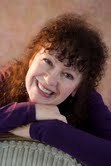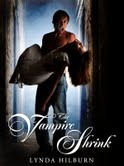Author Interview with Lynda Hilburn
 Tell us about the first book in your Kismet Knight, VampirePsychologist series, THE VAMPIRE SHRINK.
Tell us about the first book in your Kismet Knight, VampirePsychologist series, THE VAMPIRE SHRINK.Here's a brief blurb:
 Kismet Knight is a young psychologist with a growing clinicalpractice, and she's always looking for something to give her the edge in herchosen career. When her new client turns out to be a Goth teenager whodesperately wants to become a vampire, Kismet is inspired to become the vampireshrink, offering her services to people who believe they are undead. Kismetherself, as a scientist, knows it's hokum, but she's looking at it in a purelypsychoanalytic light, already imagining the papers she's going to write on thisstrange subculture. That's until she meets the leader of a vampire coven, asexy, mysterious man who claims to be a powerful 800-year-old vampire, and sheis pulled into a whirlwind of inexplicable events that start her questioningeverything she once believed about the paranormal.
Kismet Knight is a young psychologist with a growing clinicalpractice, and she's always looking for something to give her the edge in herchosen career. When her new client turns out to be a Goth teenager whodesperately wants to become a vampire, Kismet is inspired to become the vampireshrink, offering her services to people who believe they are undead. Kismetherself, as a scientist, knows it's hokum, but she's looking at it in a purelypsychoanalytic light, already imagining the papers she's going to write on thisstrange subculture. That's until she meets the leader of a vampire coven, asexy, mysterious man who claims to be a powerful 800-year-old vampire, and sheis pulled into a whirlwind of inexplicable events that start her questioningeverything she once believed about the paranormal.How longhave you been writing?
I've beenwriting nonfiction for 30 years: newspaper and magazine articles, newspapercolumns, research materials, training materials, journals, etc. Of course, someof my journal entries fell into the category of wishful thinking, whichprovided great preparation for what was to come. It wasn't until 2002 that Iseriously began exploring fiction.
How didyou pick the genre you write in?
My genre isgenerally paranormal, which includes urban fantasy, paranormal mystery,paranormal romance, erotic paranormal, dark paranormal, psychologicalparanormal, paranormal thriller, paranormal humor/satire, even paranormal withhorror elements! My love of all things dark and spooky made it impossible forme to write anything else. And, no matter how hard I try, I can't help but addextra elements. I'm always fascinated by the underlying layers of things (can'ttake the psychotherapist out of the writer).
Do youplot or do you write by the seat of your pants?
Sometimes Ireally wish I could plot. Plotting seems so organized. So efficient. Plottersseem to get so much more done. But, I'm a pantser. I never know what's comingin the story until I see it on the screen in front of me. I buy books aboutplotting and they gather dust. I am toying with the notion of being a "pantserwith plotting tendencies." We'll see how that goes! As long as I give myselfroom to completely change everything anytime I wish, I think that should work.
What drewyou to the subject of The Vampire Shrink?
The book isabout a Denver psychologist who gets pulled into a vampire underworld, andwinds up working with an unusual clientele. I've always been a vampire fan.There's just something about the various dark archetypes for these compellingand frightening creatures. The actual idea for the book came from a clientsession. I'd listened to a young woman talk about a non-human group she wantedto become part of and I began to notice that her words reminded me of some ofthe popular vampire books I'd read. She described this group (not vampires, butI do have other clients who live the Goth/vampire-wannabe lifestyle, includingdrinking blood) as if they were bloodsuckers. After the session, as I satwriting up case notes, I daydreamed about what might happen if I walked out tomy waiting room and found a gorgeous vampire sitting there. I went home thatnight and started writing. It was the most fun I've ever had writing.Tell us about yourpsychologist heroine Kismet Knight. Since you both share the same profession,do you think of her as your alter ego? I'm nodding. Kismet isdefinitely an idealized version of me: she's thinner, younger, prettier and hasa much more exciting love life than I do! I'm probably in the minority here,but I believe all characters reflect some aspect of the author's psyche. Eitherour characters represent aspects we like in ourselves, or perhaps elementswe're unconscious of. Or they're parts of ourselves we're afraid we are, orwish we were, or general archetypes available to (and parts of) everyone. Ialways smile when an author tells me her characters are separate from her.
What doyou know now that you are published that you wish you'd known sooner?
The biggestlessons I've learned have been about the business side of being an author. Ihad been used to working for myself for most of my adult life. That meant I wascomfortable charting my own course and calling the shots. Well, traditionalpublishing has its own rules and most authors (all?) have little chance ofcalling any shots. Especially in the beginning. I made lots of mistakes, mostlybecause I just didn't know any better. I kept assuming the people I worked withhad my best interests at heart and they would give me good advice. It took awhile before I understood the challenging nature of the publishing world. I hadheard all the talk from author friends about the need to grow a tough skin andmaking sure I had lots of outside support. But until I held my nose and jumpedinto the deep end of the pool, I had no idea what they meant. So, I experienceda steep and frustrating learning curve. I know much more about all aspects nowthan I did then. It's true. A writer has to cultivate both her creative sideand her business instincts. Both are equally important.How long did it take you towrite each of your two books, starting from when the idea came intoyour thoughts? From the moment I sat downto write, it took 14 months to complete The Vampire Shrink. It probablywouldn't have taken so long if I hadn't thrown my chapters away every time aparticular crit partner said I was "doing it wrong." Turns out these dearfriends (all romance writers) were trying to help me learn to write romancecorrectly, and that wasn't my focus. Once I figured out I was crossing genres,things moved much faster. I trusted my intuition more. I had an actual deadlinefor the second book, formerly called Dark Harvest, so that one took me about ayear, and it was much more difficult to write! My new publisher (Jo FletcherBooks/Quercus Books) asked me to write a new book #2 (the former book #2 willnow be a later book). I have just a few months to come up with an entire book.Yikes. I've got my fingers crossed I'm up to the challenge!
Describe your workspace.
I live in a small townhouse (smaller than my heroine's) and my office is inthe loft area. My computer sits on a huge table, surrounded by files, books,magazines, office equipment and various papers. There are vampire posters onthe walls around me. I keep the TV on in the background for noise. I can't playmusic while I write because I'm a singer and music distracts me.
Best and worst part of being a writer?
Best part is typing the words, "the end." LOL. Worst is forcing myself tosit in the chair long enough to get the words out.
Advice for other writers?
It really is true that you should never give up. Read stories about otherwriters and how many dark times they had to overcome before achieving whateverthey consider success. Just when you think it's all over, it begins again. Bepersistent, tenacious and stubborn. Keep writing. Keep laughing. Of course, nowwith all the indie publishing, it's a brave new world!
What are you writing now?
I'm working on a new second book (tentatively called Blood Therapy) in myKismet Knight, Vampire Psychologist series (and I have ideas for the book afterthat, which might push the previous book #2 back to being book #4). I also havelots of other ideas I'd like to write about. It would be great to win thelottery and be able to write full time!
How can people buy your books?
The UK version of The Vampire Shrink will be out in hardcover and tradepaperback – and hopefully ebook – September, 2011. The books can be pre-orderedat Amazon.com. The North American version should arrive early 2012. My booksshould be available everywhere.
How can readers learn more about you and your books?
Website: http://www.lyndahilburnauthor.com
Blog: http://www.paranormalityuniverse.blogspot.com
Facebook: http://www.facebook.com/lyndahilburn
Twitter: http://www.twitter.com/lyndahilburn
Published on July 27, 2011 08:30
No comments have been added yet.



